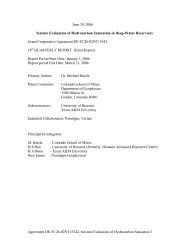Technical Review of the Lined Rock Cavern Concept and Design ...
Technical Review of the Lined Rock Cavern Concept and Design ...
Technical Review of the Lined Rock Cavern Concept and Design ...
Create successful ePaper yourself
Turn your PDF publications into a flip-book with our unique Google optimized e-Paper software.
<strong>Technical</strong> <strong>Review</strong> <strong>of</strong> <strong>the</strong> <strong>Lined</strong> <strong>Rock</strong> <strong>Cavern</strong> (LRC) <strong>Concept</strong> <strong>and</strong> <strong>Design</strong> Methodology 30<br />
Figure 4-19 illustrates <strong>the</strong> results <strong>of</strong> <strong>the</strong> UDEC model for <strong>the</strong> horizontal section in terms<br />
<strong>of</strong> cavern deformation, fracture shear displacement, <strong>and</strong> fracture separation. Although<br />
<strong>the</strong> in-situ horizontal stresses <strong>and</strong> material properties are isotropic, a non-uniform cavern<br />
displacement indicates anisotropic conditions. The apparent effect <strong>of</strong> anisotropy is a result<br />
<strong>of</strong> <strong>the</strong> fracture system <strong>and</strong>, more importantly, <strong>the</strong> fracture orientation — thus, it is an<br />
effect <strong>of</strong> material anisotropy. The direction <strong>of</strong> <strong>the</strong> largest wall displacement is indicated<br />
in Figure 4-19; it falls along <strong>the</strong> line <strong>of</strong> most wedge formation <strong>and</strong> fracture separation.<br />
Note that <strong>the</strong> purpose <strong>of</strong> <strong>the</strong>se UDEC models was not to predict accurate deformations <strong>of</strong><br />
<strong>the</strong> cavern, but to illustrate qualitatively <strong>the</strong> richness <strong>of</strong> <strong>the</strong> rock mass response embedded<br />
in <strong>the</strong>se models. At any given LRC site, rock wedges are likely to appear, <strong>and</strong> fracture<br />
separation will occur during cavern pressurization. Discontinuum analysis is an approach<br />
that considers <strong>the</strong> local aspect <strong>of</strong> <strong>the</strong>se issues in <strong>the</strong> context <strong>of</strong> predicting <strong>the</strong> steel liner<br />
strain.<br />
4.3 Concrete-Liner Fracture Analysis<br />
The development <strong>of</strong> cracks in <strong>the</strong> reinforced concrete liner can be expected as a result <strong>of</strong><br />
local deformations in <strong>the</strong> adjacent rock mass during cavern pressurization. An accurate<br />
evaluation <strong>of</strong> <strong>the</strong> size <strong>of</strong> <strong>the</strong>se cracks is important to <strong>the</strong> prediction <strong>of</strong> <strong>the</strong> associated local<br />
strain in <strong>the</strong> steel liner. In this context, <strong>the</strong> review documents present, in some detail, an<br />
approach for analyzing induced fractures in <strong>the</strong> concrete liner. The approach uses a finite<br />
element model to predict <strong>the</strong> local crack development in <strong>the</strong> concrete as induced by<br />
<strong>the</strong> separation <strong>of</strong> a vertical fracture in <strong>the</strong> rock mass. The model characterizes <strong>the</strong> concrete<br />
as a Mohr-Coulomb material with a tension cut-<strong>of</strong>f (i.e., finite tensile strength).<br />
Unless <strong>the</strong> tensile strength in each element <strong>of</strong> this model reflects <strong>the</strong> critical fracture<br />
toughness (or critical energy-release rate) <strong>of</strong> <strong>the</strong> reinforced concrete, <strong>the</strong> solution becomes<br />
mesh-dependent (Detournay et al., 2001). This can affect both <strong>the</strong> predicted crack<br />
separation <strong>and</strong> distribution.<br />
In lieu <strong>of</strong> a more sophisticated fracture propagation analysis, <strong>the</strong> finite element approach<br />
described in <strong>the</strong> review documents should use a tensile strength that reflects <strong>the</strong> material<br />
toughness <strong>of</strong> <strong>the</strong> concrete liner. An example <strong>of</strong> <strong>the</strong> derivation <strong>of</strong> this tensile strength is<br />
provided in Appendix B.

















